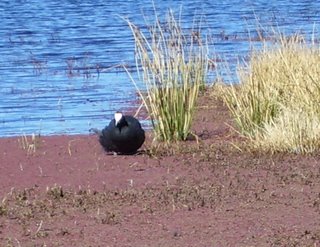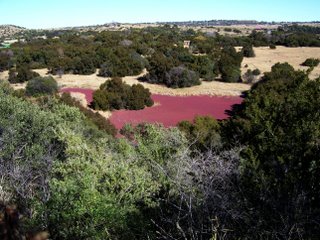Small, free-floating aquatic fern with pinnately branched rhizomes. The frond is almost moss-like, 1/16 inch long with 2 lobes, the upper lobe floating, the lower lobe larger and submerged. Sporocarps are produced by the lower lobe. The plant is native from Washington to Mexico and South America"
 View across the dam and mats of Azolla from the Bird Hide on the northen side of the dam.
View across the dam and mats of Azolla from the Bird Hide on the northen side of the dam. Some of the weed is eaten by waterfowl but not nearly enough!
Some of the weed is eaten by waterfowl but not nearly enough! A view from the Koppie down on the lower dam near the N1 highway, which is completely covered!
A view from the Koppie down on the lower dam near the N1 highway, which is completely covered! Close up of the critter. Quite pretty and I can see why people would want it in a fishpond or aquarium.
Close up of the critter. Quite pretty and I can see why people would want it in a fishpond or aquarium. A view of the main dam from the Koppie, not nearly as bad as the lower dam. The Bird hide is in the tree line on the bottom of the picture.
A view of the main dam from the Koppie, not nearly as bad as the lower dam. The Bird hide is in the tree line on the bottom of the picture. The plaque at the dam wall explaining what the weed is about. Excuse the bird droppings!
The plaque at the dam wall explaining what the weed is about. Excuse the bird droppings! "Forms dense mats that choke out other species. Azolla lives in symbiosis with blue-green algae (cyanobacteria), taking advantage of their ability to fix nitrogen. It is sometimes introduced and used by farmers as a natural fertilizer for this reason."
The probable source for our invader in the Botanic Gardens was aquatic gardens and aquariums.
What is interesting is that it can be used as a fertilizer/compost, the problem is finding a economic way to harvest it and at the same time control this pest in our dams and rivers. At least it is not as bad as Kariba Weed! Our cold winters save us from that horrid invader.

No comments:
Post a Comment